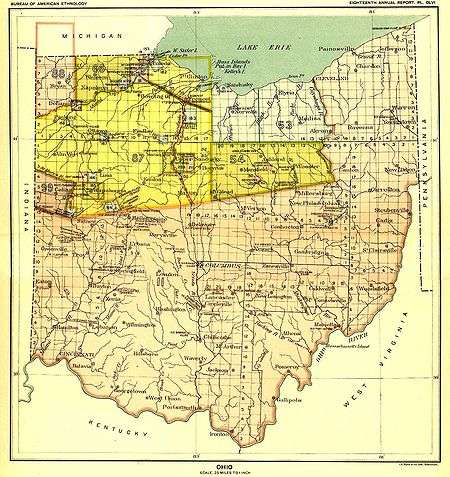Treaty of Fort Meigs
The Treaty of Fort Meigs, also called the Treaty of the Maumee Rapids, formally titled, "Treaty with the Wyandots, etc., 1817", was the most significant Indian treaty in Ohio since the Treaty of Greenville in 1795, and resulted in cession by the Indians of nearly all remaining Indian lands in northwestern Ohio. It was the last but one[2] and largest wholesale purchase of Indian land in Ohio.

The Treaty was signed September 29, 1817 between the chiefs and warriors of the Wyandot, Seneca, Delaware, Shawnee, Potawatomi, Ottawa and Chippewa tribes of Native Americans and the United States of America, represented by Lewis Cass, governor of Michigan Territory and Gen. Duncan McArthur of Ohio.
The accord contained twenty-one articles and an addendum specifying land cession, allocation of Indian reservations and individual land grants, cash compensation to be paid by the United States, and acceptance of the terms by the various tribes.
In this treaty the affiliated tribes relinquished their claim to 4.6 million acres of land in northwestern Ohio (almost 1/6 of the land area of the state), and chunks of northeastern Indiana and southern Michigan as well. The area was bounded by the Fort Industry Treaty Line in the East and the Greenville Treaty Line in the south; the western boundary angled northerly from the northwest corner of the Greenville Line (skipping around a small reservation near Loramie's store) to Kekionga then zigzagged awkwardly northwest to Lake Erie, clipping off a chunk of southeastern Michigan; the northeastern boundary was Lake Erie. In a figurative way, the land cession was the inverse of that in the pre-Greenville Treaty of Fort McIntosh: in the Fort McIntosh Treaty, the circumscribed area, which included most of northwestern and central northern Ohio, was land reserved to the Indians; in the Fort Meigs Treaty, the circumscribed area, which included most of northwestern Ohio, is land ceded to the United States. After the treaty, with the exception of some tiny Indian reservations, Ohio was owned by the Whiteman border to border. The border between ancestral Indian lands to the northwest and Whiteman's lands to the south and east shifted to Indiana, where it was defined by the Treaty of Fort Wayne (1809).
The treaty reserved: for the Wyandots 12 miles square in Upper Sandusky around Fort Ferree; for the Seneca, thirty thousand acres on the Sandusky River near Wolf Creek; for the Shawnee, 10 miles square around Wapakoneta, also for the Shawnee, 25 square miles around Wapakoneta, also for the Shawnee, 48 square miles near of the headwaters of the Little Miami and Scioto Rivers; and for use of the Ottawas but not granted to them, two tracts, one 5 miles square on the Great Auglaize River and one 3 miles square on the Little Auglaize River. The Delaware from south of the Wabash River, the Chippewa from northern Wisconsin and Minnesota, and the Potawatomi from the Mississippi Valley, were not allocated any reservations in Ohio.
In compensation, the United States agreed to pay annuities of various amounts for different lengths of time to the different tribes depending on their relative occupancy of the land. In addition, some tribes were paid cash amounts for damages they suffered as a result of allying themselves with the United States in the War of 1812.
It also introduced the practice of making grants of land to individual Indians and sometimes whitemen to encourage them to settle and farm the land. But Indians are nomadic, and as the scheme patently failed, the government was forced to buy back the reservations, and resold them to whitemen. This resulted in speculation and fraud.
The Treaty was signed five days after the laying of the cornerstone for the fledgling University of Michigan campus in Detroit. Among the treaty's provisions was the ceding of 1,920 acres (7.8 km2) of land by the Chippewa, Ottawa, and Potawatomi tribes to the "college at Detroit" for either use or sale, and an equal amount to St. Anne's Church in Detroit, where Father Gabriel Richard was rector. No college had officially been created yet, so the next month Reverend John Monteith and Father Richard decreed the creation of the "Catholepistemiad[3] of Michigania" at Detroit, which became the University of Michigan in 1821.
Addendum
The Addendum was a separate document also signed on September 29, 1817. The United States granted the Wyandot (Huron), the Seneca, the Shawnee, and the Ottawa additional sums of money for their lands. In addition, the terms of the original treaty were changed to give the Indians ownership of Indian lands instead of just use of them, effectively creating Indian reservations.
See also
- Treaty of Brownstown, ceding a strip of land for a road in Michigan and Ohio
- Treaty of Detroit, the previous treaty ceding land in northwestern Ohio
- Treaty of St. Mary's (1818), ceding the last small area of ancestral Indian land below the St. Mary's River
- Great Black Swamp; much of the ceded area consisted of this
External links
References
- Treaty of the Maumee Rapids - Ohio History Central
- Part of the treaty area in Indiana is off the map to the upper left.
- A small area below the St. Mary's River and north of the Greenville Treaty Line was ceded in the Treaty of St. Mary's in 1818.
- From Latin cathol-, "universal" + Greek episte-, "letter of knowledge" + Greek -[m]iad, "event"; loosely, "academy of universal knowledge". It was an awkwardly coined term, and probably the only instance of the word in the English language.
| Wikisource has original text related to this article: |